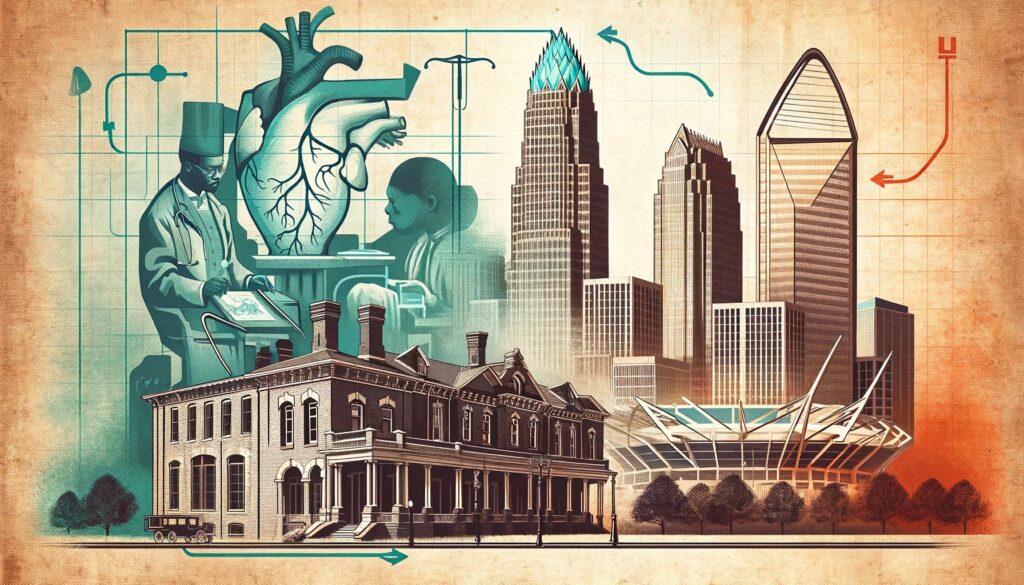
Key Takeaways:
| Takeaway | Description |
|---|---|
| Good Samaritan Hospital’s Role | First private hospital in North Carolina for Black patients, highlighting segregated healthcare in the 1890s. |
| Brooklyn Neighborhood | Built by emancipated slaves, symbolizing the resilience of African Americans in challenging environments. |
| Joe McNeely’s Lynching | A tragic event in 1913, reflecting the intense racial violence faced by African Americans. |
| Site’s Historical Significance | Current location of Bank of America Stadium, underlining the importance of acknowledging past injustices. |
| Legacy of Racial Inequities | The history of the hospital and neighborhood illustrates ongoing racial disparities in healthcare and urban development. |
| Modern Implications | Reflects the need for racial equity and integration of Charlotte’s historical context into its future development. |
Echoes of History: Charlotte’s Good Samaritan Hospital and the Brooklyn Neighborhood
Uncovering the layered past of Charlotte’s Good Samaritan Hospital and Brooklyn neighborhood – a tale of resilience and racial injustice.
By Darius Spearman (africanelements)
About the author: Darius Spearman is a professor of Black Studies at San Diego City College, where he has been pursuing his love of teaching since 2007. He is the author of several books, including Between The Color Lines: A History of African Americans on the California Frontier Through 1890. You can visit Darius online at africanelements org
Good Samaritan Hospital: A Pillar in Segregated Healthcare
In 1891, a groundbreaking institution emerged in Charlotte, North Carolina. The Good Samaritan Hospital Charlotte, a beacon in the realm of segregated healthcare, was the first private hospital built to serve Black patients in North Carolina. It stood as a testament to resilience in an era rife with racial injustice. While it offered crucial medical services, its very existence highlighted the stark disparities in healthcare access during the Jim Crow era. The hospital’s story intertwines with the struggle for racial equity, a struggle that resonates deeply in today’s African American history Charlotte.
Brooklyn Neighborhood: From Slavery to Settlement
The late 1800s saw the birth of the Brooklyn neighborhood in Charlotte, constructed by men and women who had tasted the bitterness of slavery yet dared to dream of a community of their own. This neighborhood, a manifestation of Black communities Charlotte, was pushed onto low-lying lands prone to flooding and sanitation problems. Yet, against all odds, it thrived. The history of Brooklyn not only symbolizes the physical and emotional toil of its founders but also represents a microcosm of the broader African American experience, marked by tenacity and triumph over systemic challenges.
The Lynching of Joe McNeely
In 1913, Charlotte witnessed a harrowing event that would forever scar its history. Joe McNeely, a 22-year-old African American man, became the victim of a brutal lynching, a stark reminder of the racial animosity of the time. This incident, occurring near the grounds of Good Samaritan Hospital, underscored the gravity of racial injustice North Carolina. The lynching of Joe McNeely is not just a historical footnote; it’s a vivid example of the deep-seated racism that African Americans faced, mirroring the broader narrative of racial violence in America.
The story of the Good Samaritan Hospital and the Brooklyn neighborhood is one of resilience and injustice, of communities forging their path amidst adversities. It’s a story that demands reflection and recognition, a critical chapter in the tapestry of African American history in Charlotte. As we delve deeper into this narrative, we uncover the layers of struggle and survival that define the African American experience in the South.
Transforming Healthcare: Good Samaritan’s Legacy
The legacy of the Good Samaritan Hospital extends beyond its physical presence. As North Carolina’s first private hospital for African Americans, Good Samaritan played a pivotal role during the Jim Crow era, a time when segregated healthcare history was deeply entrenched in society. It served as a beacon of hope and a symbol of the ongoing fight for equal healthcare access. Even after its closure, the spirit of Good Samaritan continues to inspire conversations about health disparities in the African American community.
Key Milestones of Good Samaritan Hospital:
- 1891: Hospital’s inception, providing a critical healthcare option for African Americans.
- 1903: Opening of its own School of Nursing, contributing to the education and empowerment of Black nurses.
- 1961: Transition to Charlotte Community Hospital, marking a step towards healthcare integration.
The Brooklyn Neighborhood’s Evolution
Over time, the Brooklyn neighborhood underwent significant transformations, reflecting the broader socio-economic shifts in Charlotte. It evolved from a settlement built by freed slaves into a vibrant community, despite the challenges posed by its geographical location. The story of Brooklyn is not just about the physical space it occupied but also about the resilience and solidarity of its inhabitants, who navigated the complexities of life in a segregated city.
Brooklyn Neighborhood Over the Years:
- Late 1800s: Formation by emancipated slaves.
- Early 1900s: Growth into a thriving Black community.
- Mid-20th Century: Displacement and redevelopment, leading to the loss of its original character.
The Unspoken Truths: Unearthing the Past
The history of the Bank of America Stadium, now standing where the Brooklyn neighborhood and Good Samaritan Hospital once were, is intertwined with these unspoken narratives. The Bank of America Stadium history is more than just the story of a sports complex; it’s a tale that encompasses the erasure and displacement of a significant African American community. Acknowledging this history is crucial in understanding the complex tapestry of Charlotte’s past and the ongoing impact of racial and urban policies.
The journey through Charlotte’s past reveals not just the hardships and injustices faced by the African American community but also their unyielding spirit and contributions to the city’s history. This exploration into the past is not just about remembering what was lost but also about learning and growing from these experiences, ensuring that such histories are not forgotten.
As we move to the concluding part of this narrative, we delve into the implications of these historical events on present-day Charlotte and the lessons they offer for a more equitable future.
Toward a More Equitable Future: Learning from the Past
The story of Good Samaritan Hospital and the Brooklyn neighborhood is not just a relic of the past. It serves as a poignant reminder of the enduring struggles for racial equity in Charlotte and beyond. These historical landmarks, now replaced by modern structures, hold lessons that are crucial in shaping a more inclusive future.
Implications for Today’s Charlotte:
- Healthcare Access: The legacy of Good Samaritan Hospital underscores the ongoing need to address health disparities in the African American community.
- Urban Development: The transformation of the Brooklyn neighborhood highlights the impact of urban policies on minority communities and the importance of preserving cultural heritage.
Integrating History with Modern Charlotte
As Charlotte continues to evolve, integrating its complex history into the fabric of the city is essential. The lessons learned from the Good Samaritan Hospital and the Brooklyn neighborhood should inform current policies and initiatives aimed at achieving racial and social justice. This integration can help in building a Charlotte that honors its past while paving the way for an equitable future.
Steps Toward Integration:
- Educational Initiatives: Incorporating Charlotte’s racial history into educational curricula to foster awareness and understanding.
- Commemorative Efforts: Establishing memorials or museums to honor the legacy of these historically significant sites and the African American community.
Conclusion: Echoes of Resilience and Hope
The echoes of Charlotte’s Good Samaritan Hospital and Brooklyn neighborhood resonate with stories of resilience, struggle, and hope. They remind us of the importance of acknowledging and learning from our past to create a more just and equitable society. As we reflect on these stories, let us commit to recognizing and valuing the contributions of the African American community in shaping the history and future of Charlotte and the nation.
FAQ Section:
Q: What was the significance of the Good Samaritan Hospital?
A: It was the first private hospital in North Carolina built to serve African Americans, symbolizing a pivotal moment in the history of segregated healthcare.
Q: Why is the Brooklyn neighborhood important in Charlotte’s history?
A: Built by emancipated slaves, it represents the resilience of African Americans in creating their community against the backdrop of segregation and discrimination.
Q: How does the history of these sites impact Charlotte today?
A: It highlights the need to address ongoing racial disparities and integrate this history into the city’s development for a more equitable future.
